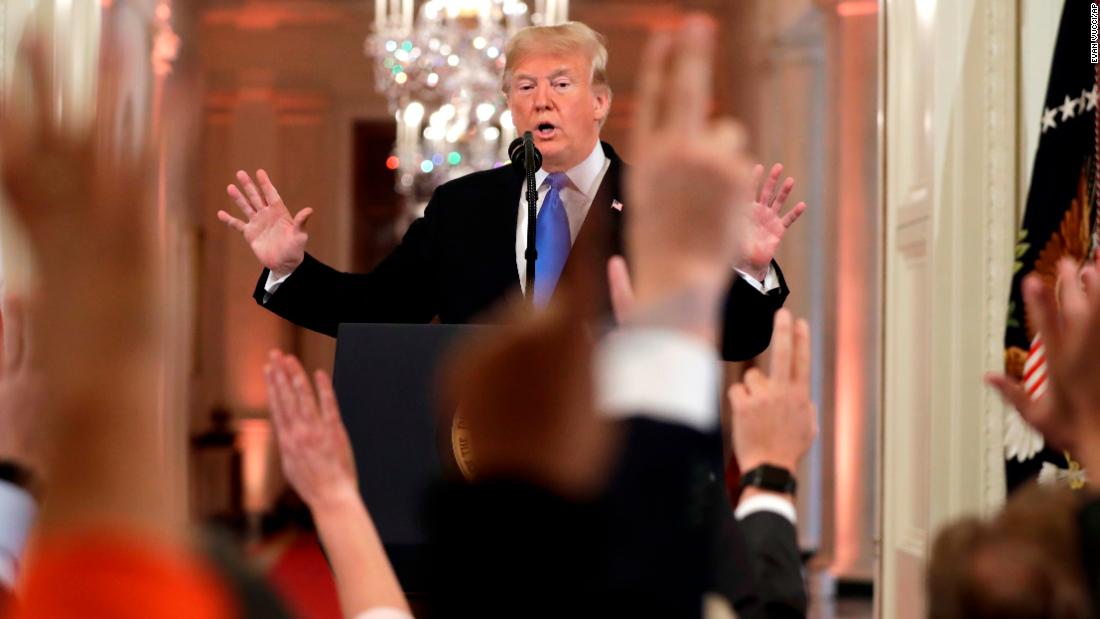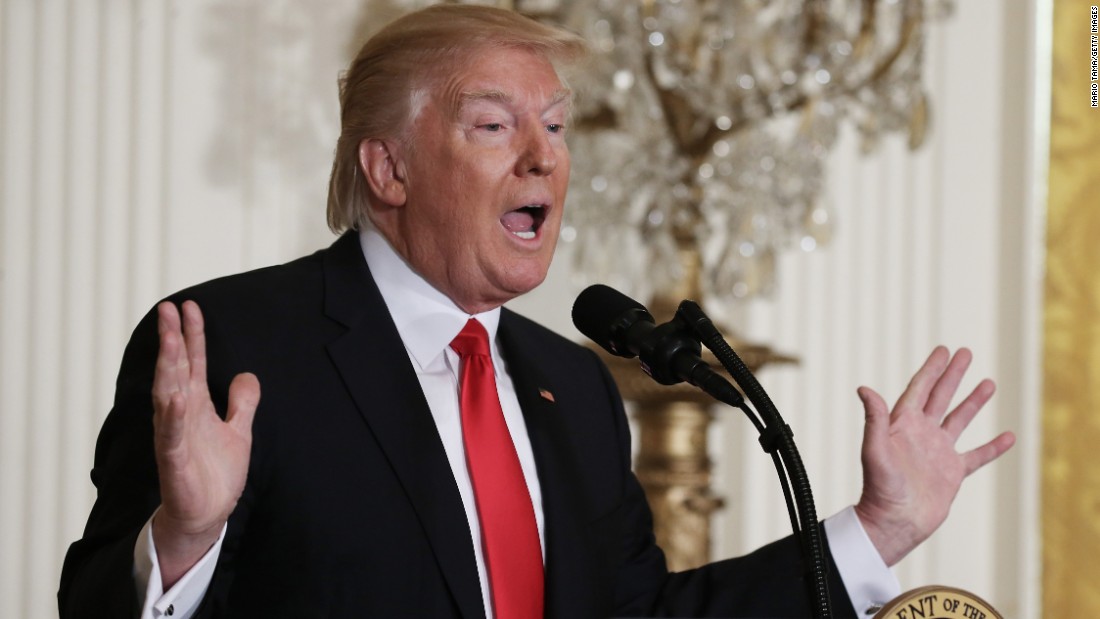Trump Press Conference Characteristics

Donald Trump’s press conferences were a unique and often controversial aspect of his presidency. His style and approach to interacting with the press differed significantly from his predecessors, sparking numerous debates and analyses. This section delves into the key characteristics of his press conferences, examining their format, language, recurring themes, and comparison with previous presidents.
Format and Structure
Trump’s press conferences typically followed a loose structure, often deviating from traditional norms. While some events featured a formal opening statement followed by a Q&A session, others were more free-flowing and less structured. A hallmark of his press conferences was their length, often exceeding the typical duration. He frequently addressed a wide range of topics, sometimes veering off-topic to address personal grievances or engage in self-promotion.
Language and Rhetoric, Trump press conference
Trump’s use of language was a defining feature of his presidency. He employed a distinct style characterized by short, declarative sentences, repetition, and the use of superlatives and hyperbole. He often used inflammatory rhetoric, making bold claims and attacking his opponents with aggressive language. His pronouncements were frequently delivered with a theatrical flair, employing gestures and facial expressions to emphasize his points.
Recurring Themes and Talking Points
Throughout his press conferences, Trump frequently revisited a set of recurring themes and talking points. These included highlighting his accomplishments, emphasizing his “America First” agenda, criticizing the media, and attacking his political opponents. He often presented his perspective on various issues as the only true or correct one, dismissing alternative viewpoints as “fake news.”
Comparison with Previous Presidents
Trump’s press conference style differed significantly from that of previous presidents. Unlike his predecessors who typically held more structured and formal events, Trump’s press conferences were often more chaotic and less predictable. His frequent attacks on the media and his use of inflammatory rhetoric were also a departure from the more restrained approach of previous presidents.
Media Coverage and Public Perception

Donald Trump’s press conferences have been a significant source of media coverage and public discussion. His unique style and frequent controversial statements have captivated audiences and sparked debates across the political spectrum. The media’s portrayal of these events, coupled with public reactions, has shaped public perception of Trump and his administration.
Media Portrayal of Trump’s Press Conferences
The media’s coverage of Trump’s press conferences has been characterized by a mixture of fascination and scrutiny. Many outlets have focused on the dramatic and often confrontational nature of these events, highlighting Trump’s tendency to make bold claims, attack his opponents, and engage in heated exchanges with reporters. This focus on the sensational aspects has often led to a polarized view of Trump’s press conferences, with some outlets presenting him as a charismatic and outspoken leader, while others portray him as a reckless and divisive figure.
Public Opinion and Reactions to Trump’s Statements
Public opinion regarding Trump’s press conferences has been equally divided. Some individuals find his directness and willingness to challenge the status quo refreshing, while others find his rhetoric offensive and divisive. The impact of his statements on public opinion is complex and often depends on individual political leanings and pre-existing beliefs.
The Impact of Social Media on the Dissemination of Information
Social media platforms have played a significant role in the dissemination of information about Trump’s press conferences. These platforms have allowed for the rapid sharing of news clips, quotes, and commentary, often with a strong partisan bias. The ease with which information can be spread on social media has contributed to the polarization of public opinion, as individuals are increasingly exposed to information that confirms their existing beliefs.
Comparison of Coverage with Other Events
The coverage of Trump’s press conferences has often been compared to the coverage of other political events, such as debates, speeches, and rallies. While other events may receive significant media attention, the unique nature of Trump’s press conferences, with their frequent controversies and unpredictable moments, has often made them a major news story. The level of scrutiny and public interest surrounding Trump’s press conferences is often higher than that of other political events, reflecting his status as a polarizing figure in American politics.
Historical Context and Significance: Trump Press Conference

Trump’s press conferences have become a defining feature of his presidency, generating significant controversy and sparking debate about the role of the press in a democratic society. To fully grasp the significance of these events, it’s essential to analyze them within the historical context of American politics and assess their impact on the political landscape.
Press Conferences in American Politics
Press conferences have been a cornerstone of American politics since the early 20th century, serving as a platform for presidents to communicate directly with the public and address pressing issues. These events have evolved over time, reflecting changes in media technology and the political climate.
- Early Press Conferences: In the early days of the republic, presidents primarily communicated through written statements and public addresses. The first formal press conference was held by President Woodrow Wilson in 1913, marking a shift towards a more direct and interactive form of communication.
- The Rise of Television: The advent of television in the mid-20th century revolutionized presidential communication. Press conferences became televised events, allowing presidents to reach a wider audience and engage in more visual and impactful forms of communication.
- The Era of Spin: The late 20th century saw the rise of “spin” in politics, with presidents and their staffs increasingly focusing on controlling the narrative and managing public perception. This led to a more strategic approach to press conferences, with carefully crafted messages and tightly controlled environments.
Trump’s Press Conferences: A Departure from Tradition
Trump’s press conferences have departed significantly from the established norms and traditions of his predecessors. He has embraced a more confrontational and combative approach, frequently attacking the press, questioning the legitimacy of their reporting, and using press conferences as platforms to promote his agenda and advance his political goals.
- Combative Rhetoric: Trump’s press conferences are often characterized by aggressive language, personal attacks on journalists, and accusations of bias and dishonesty. This approach has fueled tensions between the White House and the press, contributing to a more adversarial relationship.
- The Spread of Misinformation: Trump’s press conferences have also been criticized for the spread of misinformation and false claims. He has frequently made unsubstantiated statements, contradicted his own advisors, and promoted conspiracy theories, raising concerns about the accuracy and reliability of information disseminated through these events.
- The Role of Social Media: Trump’s use of social media has further complicated the relationship between the White House and the press. He often bypasses traditional media outlets, using Twitter and other platforms to communicate directly with his supporters and circumvent the press. This has led to a more fragmented media landscape and increased challenges for journalists in verifying information.
Impact on the Political Landscape
Trump’s press conferences have had a profound impact on the political landscape, contributing to a more polarized and distrustful environment. His confrontational style and disregard for journalistic norms have eroded public trust in the media, while his frequent attacks on the press have emboldened his supporters and further fueled partisan divisions.
- Erosion of Trust: Trump’s relentless attacks on the media have eroded public trust in journalism, leading to increased skepticism about the accuracy and objectivity of news reporting. This has created a more challenging environment for journalists to perform their role as watchdogs and hold the government accountable.
- Polarization and Partisanship: Trump’s press conferences have contributed to the increasing polarization of American politics. His supporters often see his confrontational approach to the press as a sign of strength and defiance, while his critics view it as an attack on democratic values and a threat to press freedom.
- The Rise of Fake News: Trump’s rhetoric has also contributed to the rise of “fake news,” with his supporters often dismissing any critical reporting as biased or dishonest. This has made it more difficult to distinguish between credible information and misinformation, further eroding trust in the media and contributing to a more fragmented information landscape.
Historical Comparisons
Trump’s press conferences can be compared to significant historical events that have shaped the relationship between the press and the government in the United States.
- The Watergate Scandal: The Watergate scandal, which led to the resignation of President Richard Nixon, demonstrated the crucial role of the press in holding the government accountable. The investigative reporting of journalists like Carl Bernstein and Bob Woodward exposed Nixon’s illegal activities, leading to his downfall.
- The Vietnam War: The Vietnam War era saw a growing distrust of the government and a rise in anti-war sentiment. The press played a critical role in covering the war, exposing its brutality and questioning the government’s justifications for continued involvement. This led to a more adversarial relationship between the government and the press, with journalists often challenging the official narrative.
Trump press conference – Trump’s press conferences were always a whirlwind of information, sometimes accurate, sometimes… well, less so. It’s fascinating to compare those events to the more structured format of a debate, like the one hosted by ABC, which you can find a detailed analysis of here.
In a debate, there’s a bit more pressure to stick to the facts, and that’s something that was always a bit of a challenge for Trump’s press conferences.
Trump’s press conferences were often chaotic, a whirlwind of accusations, denials, and sometimes, even outright falsehoods. But amidst the storm, there were journalists like David Muir, a journalist whose calm demeanor and probing questions stood out, reminding everyone of the importance of truth and accountability in the face of such volatility.
These press conferences, while often polarizing, served as a stage for crucial conversations about the state of the nation, and the role of the media in holding power to account.
